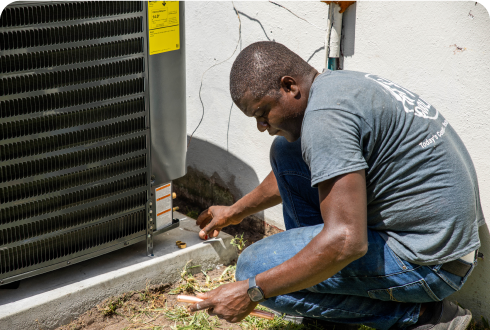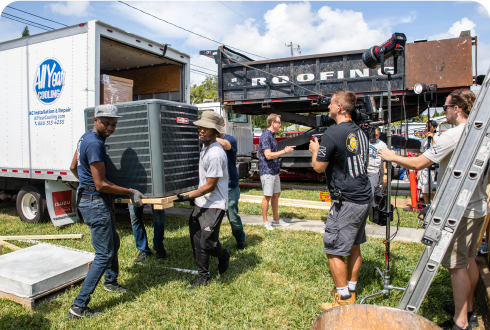Blow-In Fiberglass Insulation
Blow-in fiberglass insulation is commonly used to reinsulate existing homes. It can be blown into attics and into wall cavities both in new construction and existing homes.
Adding blown fiberglass insulation to your attic or enclosed exterior walls is a cost effective way to add R-value to your home, protecting it from the loss of conditioned air while improving overall comfort and energy efficiency.
Our roofs are exposed to different variations of heat throughout the year. Specifically, from March 22nd to September 21st South Florida has more direct heat than the rest of the year. During this time frame, the temperature in the attic may rise close to 140⁰ F. The attic space becomes a heat reservoir and the heat flows from the ceiling into the home’s living space.
How Insulation Works
To understand the importance of attic insulation, it helps to know how insulation works. Insulation may be blown in to fill spaces between the attic ceiling and floors and the rest of the home. The goal is to prevent a layer of fiberglass, foam, or blown cellulose insulation that prevents the transfer of hot air to cold air and vice versa.
On a hot day, an attic may reach temperatures of well over 120 F. The heat looks for cooler areas, so it will push its way down to lower levels. That heats up the lower rooms, while the cooler air enters the attic and may escape the home through gaps.
Uninsulated attics in Florida are recommended to have upwards of 14 inches of:
- R-30 to R-49 in Zone 1
- R-49 to R-60 in Zone 2
If the attic is already insulated:
- R-19 to R-38 in Zone 1
- R-38 to R-49 in Zone 2
R-38 is usually a target area for residents of Florida with any attic. R-13 or better is recommended for the floors in both zones.
How do you know what your attic insulation’s R-value is? Insulation’s R-values are calculated by the inch.
- Cellulose (Blown) – 3.1 to 3.8
- Fiberglass (Batts/Rolled) – 2.9 to 3.8
- Fiberglass (Blown) – 2.2 to 2.9
- Foam (Sprayed) – 3.6 to 8.2
- Rock Wool (Loose) – 2.2 to 3.3
With those values, multiply the inches of insulation currently in your attic by the R-values above. If you have five inches of rolled fiberglass insulation, 5 inches x 2.9 to 3.8 puts the current range at R-14 to R-19. If your R-value isn’t upwards of R-38, it’s time to add more insulation to bring up the value to the correct range.
Do You Need to Replace It?
What are some of the signs that your insulation needs replacement or improvement? There are several things to look for.
Higher Utility Bills
You’re finding your utility bills have increased drastically. You’ve checked out your ducts and don’t see any issues. You had your AC cleaned and inspected and it’s fine. It’s time to look at the attic insulation to see if there are issues. Several factors can cause your AC to run more, and poor insulation is one of them.
Animals and Rodent Infestations
Mice and other rodents may have made a home in your insulation. This often depends on the type of insulation that’s used, but if they like it, they’ll pack some down for a nest and chew up other areas, creating the drafts you don’t want.
Larger animals like raccoons may find their way into your attic through a broken ventilation window. Raccoons can do a lot of damage to insulation. How will you tell if there are infestations or animals causing damage?
You’re running your air conditioner all summer long, but some of that cold air is finding its way into the holes rodents create and leak out of your attic space. Your AC works harder, wearing out sooner, and that drives up your utility bills and has you replacing your AC before you expected to. An attic insulation inspection ends up being a cost-effective service.
Dampness
Even a small leak in your roof can cause tremendous damage. Water will find its way in during a rainstorm, Even a small amount of water can create mold and mildew, both of which damage your insulation. You don’t even have to have rain. An excessively humid home that doesn’t have a properly vented attic may find humidity building up in the attic and create mildew.
Sunlight
If there are windows in the attic, UV light comes in and can wear out some types of insulation over time. Fiberglass insulation holds up to UV rays, though the binders may be affected by UV lighting. Insulation that’s made from polyurethane foam will start to degrade over time. Over time, UV rays are able to heat up the plastic and make it brittle.
Wear and Tear
As homes age, they settle. That’s a natural part of a home’s aging process. Most settling is normal, but it can create small pockets where insulation shifts slightly and needs a touch-up to fill small gaps. If you don’t address those air gaps, you could experience leaks that allow your cool air to escape.
Hire a Professional to Inspect Your Attic Insulation
Do you know what kind of insulation is in your attic? It’s a good idea to find out. If your insulation is decades old, it’s time to have it checked for damage or wear. Thin areas need addressing. All Year Cooling & Plumbing is an expert in replacing or improving your home’s insulation.
Attic insulation is a crucial component of any home’s heating or cooling system. You want to trap cool air in your home in the warmer months and ensure you’re not experiencing heat loss in the winter. Improper insulation allows air to leak from your roof and drives up your utility bills.
To keep cold or warm air in, your attic needs to be properly insulated. You might think that your attic was insulated when it was built, so you’re good. It’s not that easy. Moisture, animals, dirt, UV rays, and wear and tear can all cause the insulation to deteriorate over time. When was the last time a professional checked out your insulation and added more insulation to fill holes or replaced damp sections?
It’s important to have an expert look at your attic insulation. You might find it’s fine and no changes are required. But if you do need more insulation, have a pro add it to ensure you’re not losing heat or cooling to degraded insulation. All Year Cooling & Plumbing’s experts are happy to come to your home and inspect your attic and AC system to ensure you’re not wasting money by having insufficient insulation. Call or go online to request a professional consultation.



